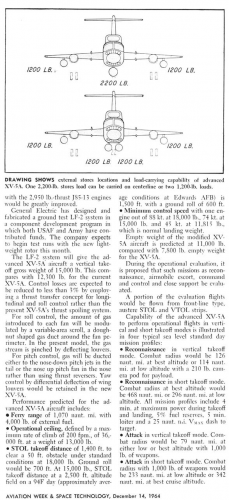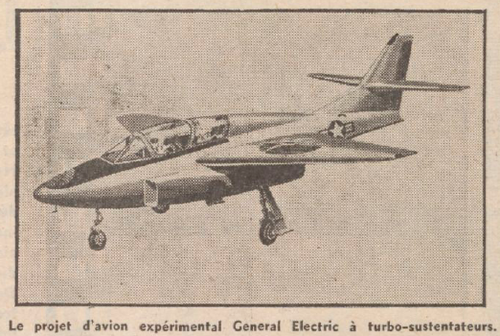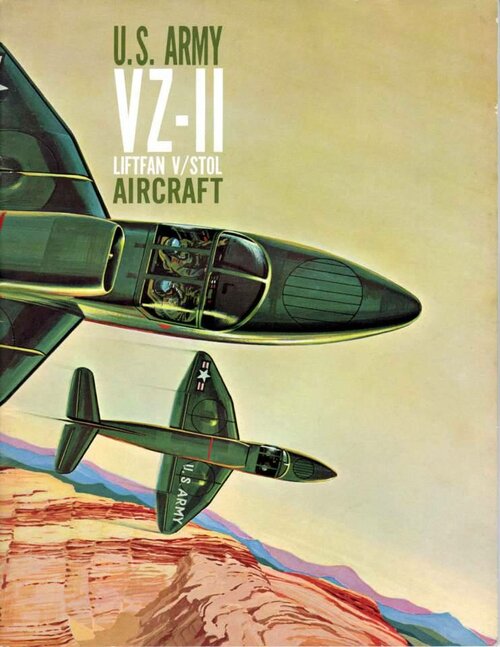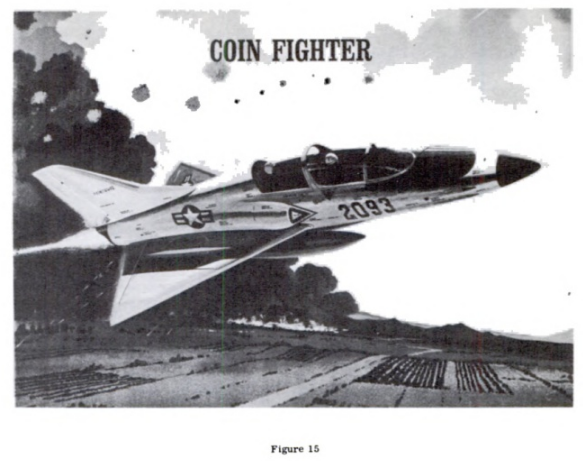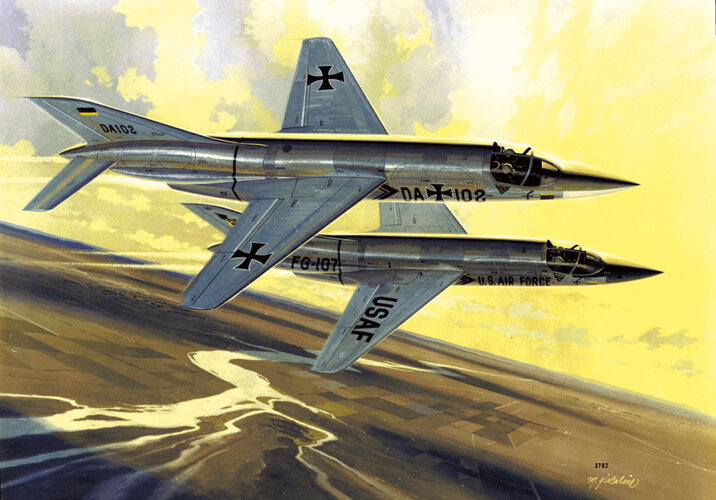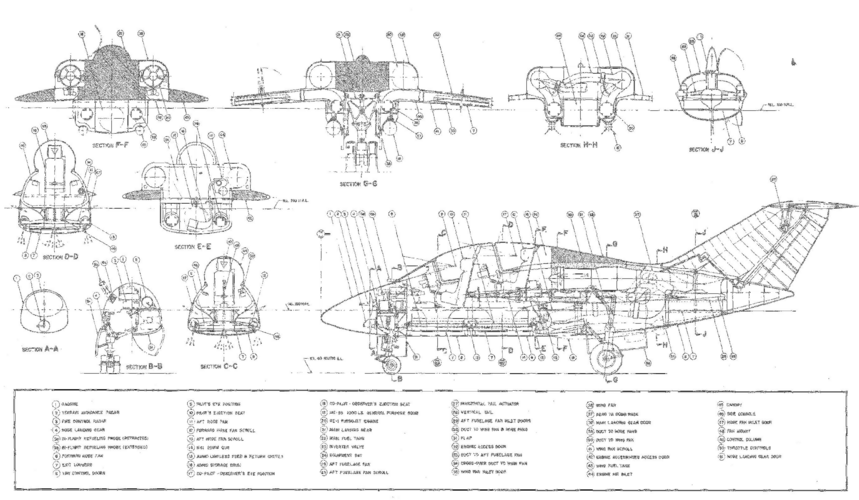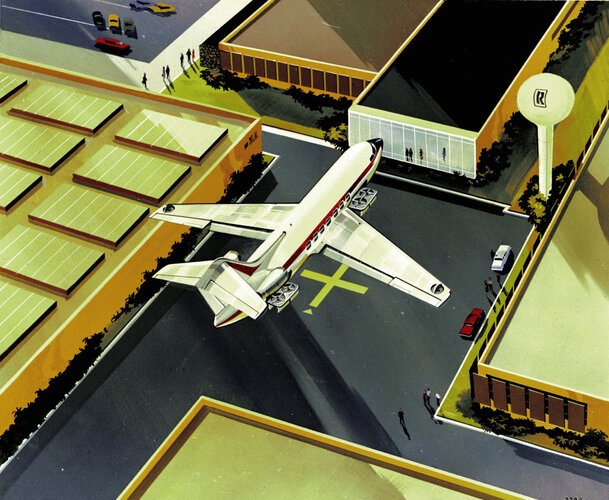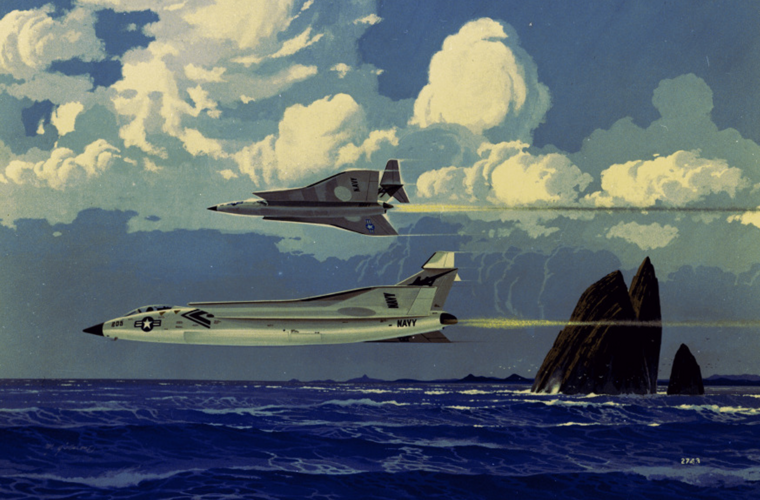You are using an out of date browser. It may not display this or other websites correctly.
You should upgrade or use an alternative browser.
You should upgrade or use an alternative browser.
Ryan XV-5 and beyond - Liftfan VTOL designs
- Thread starter Antonio
- Start date
- Joined
- 29 January 2008
- Messages
- 914
- Reaction score
- 2,036
- Joined
- 26 May 2006
- Messages
- 34,828
- Reaction score
- 15,707
Unknown USA VTOL Surveillance & Recce Aircraft Project of 1960s
here is unknown VTOL surveillance and recce low-wing aircraft project of 1961,intended for
army and had a lift fans in fuselage,can anyone ID it ?,page 33;

Flying Magazine
books.google.com.eg
Also I think the Douglas D-793 was involved in this competition ?.
- Joined
- 26 May 2006
- Messages
- 34,828
- Reaction score
- 15,707
Unknown USA VTOL Surveillance & Recce Aircraft Project of 1960s
here is unknown VTOL surveillance and recce low-wing aircraft project of 1961,intended for
army and had a lift fans in fuselage,can anyone ID it ?,page 33;

Flying Magazine
books.google.com.eg
Also I think the Douglas D-793 was involved in this competition ?.
Now,we can say about this contest,maybe the tenders were;
- North American CL-4035 (T2J-1 VTOL)
- Ryan/GE Model-? ,sure was in
- Douglas D-793
- Grumman G-260 ,sure was in,it had a fan lift in center inboard section of the wing
- Joined
- 26 May 2006
- Messages
- 34,828
- Reaction score
- 15,707
Unknown USA VTOL Surveillance & Recce Aircraft Project of 1960s
here is unknown VTOL surveillance and recce low-wing aircraft project of 1961,intended for
army and had a lift fans in fuselage,can anyone ID it ?,page 33;

Flying Magazine
books.google.com.eg
Also I think the Douglas D-793 was involved in this competition ?.
Now,we can say about this contest,maybe the tenders were;
- North American CL-4035 (T2J-1 VTOL)
- Ryan/GE Model-? ,sure was in
- Douglas D-793
- Grumman G-260 ,sure was in,it had a fan lift in center inboard section of the wing
Maybe Bell D-2021 was involved.
- Joined
- 26 May 2006
- Messages
- 34,828
- Reaction score
- 15,707
Browsing through an old index of blueprints (probably from SDASM) I've just come across the mention of a VTO-Executive variant of the Vertifan, also under the Model 143 designation. The closest thing I've found to this description in my files is this Vertifan project, but I can't say for sure if it's just that, or another project of the same era.
From AW 1960,
I think this aircraft was intended for that competition;
Unknown USA VTOL Surveillance & Recce Aircraft Project of 1960s
Attachments
- Joined
- 25 January 2020
- Messages
- 1,279
- Reaction score
- 1,948
I was looking through some articles on "The Drive", and I found this:

 www.thedrive.com
www.thedrive.com
Hopefully it hasn't been posted here already, if it has, I ask the moderators to delete this post.
Regards,
Wyvern

Ryan Had Big Plans for Its Vertifan Jump Jet
Company artwork shows proposals for vertical take-off and landing fighter jets, interceptors, sub hunters, and more.
Hopefully it hasn't been posted here already, if it has, I ask the moderators to delete this post.
Regards,
Wyvern
- Joined
- 26 May 2006
- Messages
- 34,828
- Reaction score
- 15,707
- Joined
- 26 May 2006
- Messages
- 34,828
- Reaction score
- 15,707
I still don't find the original site for this report,From University of Illinois at Urbana–Champaign project hummingbird 1961,
but I get it from Google-books,and here is with more Info.
Attachments
Last edited:
- Joined
- 26 May 2006
- Messages
- 34,828
- Reaction score
- 15,707
Here is the source,From NASA, Vertical and Short Takeoff and Landing V/STOL Aircraft 1964,
the No.23 was a Navy VAX concept,and No.26 is
the XV-5 Development
and a list for Ryan Projects,I can't read it all,also a Model-173,
with some VTO designs,maybe for Ryan ?.
Attachments
- Joined
- 13 August 2007
- Messages
- 8,411
- Reaction score
- 10,888
Where there some German Connection for Vertifan ?
Ryan Model 190 is based on F-104G (G for Germany)
Next if found two picture that show Aircraft that look like Model 187b
one of the aircraft has Luftwaffe Marking
Image source: SDASM Archives
Ryan Model 190 is based on F-104G (G for Germany)
Next if found two picture that show Aircraft that look like Model 187b
one of the aircraft has Luftwaffe Marking
Image source: SDASM Archives
Attachments
- Joined
- 26 May 2006
- Messages
- 34,828
- Reaction score
- 15,707
Unknown USA VTOL Surveillance & Recce Aircraft Project of 1960s
here is unknown VTOL surveillance and recce low-wing aircraft project of 1961,intended for
army and had a lift fans in fuselage,can anyone ID it ?,page 33;

Flying Magazine
books.google.com.eg
Also I think the Douglas D-793 was involved in this competition ?.
Now,we can say about this contest,maybe the tenders were;
- North American CL-4035 (T2J-1 VTOL)
- Ryan/GE Model-? ,sure was in
- Douglas D-793
- Grumman G-260 ,sure was in,it had a fan lift in center inboard section of the wing
Maybe Bell D-2021 was involved.
From, Основы проектирования самолетов с вертикальным взлетом и посадкой,
the Ryan two proposals,and one from Flickr
Attachments
- Joined
- 27 December 2005
- Messages
- 17,712
- Reaction score
- 26,174
From Tailoring the Lift Fan V/STOL Concept to Mission Requirements
https://doi.org/10.4271/650196
https://doi.org/10.4271/650196
Attachments
taildragger
You can count on me - I won a contest
- Joined
- 2 November 2008
- Messages
- 404
- Reaction score
- 502
As proposed, the McDonnell Douglas entry into the JSF competition used a lift system consisting of vectored thrust from the main engine + a lift engine. I've been told by a Boeing-St. Louis engineer (former McDonnell Douglas) that the USMC had pushed for a tip-driven lift fan approach but that McD couldn't make the ducting work in the available volume. The lift engine proposal was reportedly seen by the USMC as something of a betrayal after decades of partnership on the Harrier since it seemed to anticipate the abandonment of the Marines' V/STOL variant. The lift engine approach is less-than-ideal for the V/STOL operator (an engine and supporting systems that are dead weight in forward flight, probable lower reliability, additional maintenance and logistics burdens) and, of the possible configurations, would be most easily converted into a conventional aircraft by their removal.Wow thanks. Fan stream was too hard to resue pilot.
It's the same idea of Mcdonnell Douglas Joint Strike Fighter lift fan concept.
F-35B's lift fan is shaft drive.
- Joined
- 26 May 2006
- Messages
- 34,828
- Reaction score
- 15,707
From NASA, Vertical and Short Takeoff and Landing V/STOL Aircraft 1964,
the No.23 was a Navy VAX concept,and No.26 is
the XV-5 Development
All Ryan concepts are familiar,except this one ?!.
Attachments
- Joined
- 29 January 2008
- Messages
- 914
- Reaction score
- 2,036
Scott Kenny
ACCESS: USAP
- Joined
- 15 May 2023
- Messages
- 11,427
- Reaction score
- 13,935
Even by 1965, long-range SAMs had replaced point defense interceptors...Model 186C
Supersonic, powered by two reheated GE-1 engines and with VTO weight 30,000lb. The efflux from the engines is ducted to eight fans mounted in the 3.25% wings. Confguration suitable for point defence duties, with max speed of Mach 2.0. However, it has too large wetted area for low level flight, an unsuitable planform for ground attack, and insufficient span for good ferry range.
Source:
Flying Review International, August 1965
It's certainly a work of art in how simply they achieved VTOL.PS Everything I do / read etc in this field further reinforces my opinion that the Harrier is a work of genius.
It's just kinda too bad that they never did make a straight-flow version of the Pegasus, I've seen reports of upwards of 28,000lbs thrust without water injection or afterburners for such a design! The afterburning cousin design, the BS100, made 39,500lbs thrust in AB.
Even more fun, the Pegasus is 48" in diameter, just like the TF30 and F110: Imagine an F-14 with two of those engines!
Definitely still looking for a way around Key West. The Army is STILL looking for a way around Key West, but they can't lobby Congress to save their lives. I think if a new version of the law gets passed, it needs to make everything subsonic officially part of the Army's remit.Either that or they were still looking for a way around the Key West Agreement
=====
I wonder: Are modern engines enough lighter and more efficient that we could make a vertifan A4 and still have any range left?
- Joined
- 26 May 2006
- Messages
- 34,828
- Reaction score
- 15,707
- Joined
- 6 November 2010
- Messages
- 5,251
- Reaction score
- 5,480
From Jane's all the World's Aircraft 1962-63.
THE GENERAL ELECTRIC X353-5
CONVERTIBLE LIFT FAN SYSTEM
The X353-5 lift fan system is designed to provide propulsion for VTOL aircraft through the lift, hover, transition and horizontal flight phases. The system has three basic components, comprising the lift fan, the diverter valve and a J85 turbojet engine which serves as a gas generator for the vertical phase and as a conventional turbojet for horizontal flight.
The system can be installed either in the wings of an aircraft or in the fuselage. Extensive full-scale static and wind tunnel testing has demonstrated its mechanical integrity and predicted performance. The diverter valve, which directs gas flow from the turbojet to the fan turbine, was developed in a separate programme that included hot gas testing.
The X353-5 is used in the “fan-in-wing” Ryan XV-5A VTOL research aircraft (which see).
By replacing the diverter valve with an elbow and removing the exit louvres, the X353-5 can be used as a pure lift engine.
The fan can be used with several gas generators without compromising system simplicity or performance.
Available details of the X353-5 are as follows.
BASIC GAS GENERATOR.-- A standard J 85-GE-5 turbojet, used without afterburner. Fixed conical nozzle mounted at rear of engine.
DIVERTER VALVE.-- Directs gas flow from turbojet to tip-driven turbine.
SCROLL.-- Hot gas flow enters circular scroll inlet and is split into two arms of the scroll, where gas is directed at blades of the power turbine.
POWER TURBINE.-- Tip-turbine blades mounted on rim of fan are driven by turbojet exhaust gases, turning the large coaxial fan.
FAN.-- Single-stage, with tip speed of 720 ft./sec. (220 m./sec.). Variable exit louvres control direction of airflow for hover, transition from vertical to horizontal flight or vice versa, and acceleration, louvres close during normal cruising flight to present a smooth wing surface. Fan pressure ratio l-1 : l. Fan air flow 535 lb (243 kg) sec.
DIMENSIONS.--
Fan installed dimension (distance between wing spars) 76 in. (l-93 m)
Fan tip diameter 62-5 in. (1-59 m)
Fan max. thickness 14-4 in. (0-366 m)
WEIGHT.--
Dry, including fan, diverter valve and gas generator 1,145 lb (520 kg)
PERFORMANCE RATINGS.--
Lift thrust 7,430 lb (3,370 kg)
Horizontal thrust 2,580 lb (1,170 kg)
SPECIFIC FUEL CONSUMPTIONS.--
Lift thrust 0.34
Horizontal thrust 0.98
Attachments
- Joined
- 26 May 2006
- Messages
- 34,828
- Reaction score
- 15,707
Attachments
- Joined
- 25 June 2009
- Messages
- 14,731
- Reaction score
- 6,069
Yep. A USAF combat version. Similar to the version in the images below except for being a tandem-seater.I think this one was developed from XV-5 ?
Could be the the Model 162 VTOL strike/recon plane, but it's only guesswork.
The images below depict the Model 177, which is almost the same as your picture except for side-by-side seating.
The other planned USAF version was the Model 230 CARA (Combat Aircrew Recovery Aircraft).
Attachments
Last edited:
- Joined
- 26 May 2006
- Messages
- 34,828
- Reaction score
- 15,707
Yep. A USAF combat version. Similar to the version in the images below except for being a tandem-seater.
Could be the the Model 162 VTOL strike/recon plane, but it's only guesswork.
The images below depict the Model 177, which is almost the same as your picture except for side-by-side seating.
The other planned USAF version was the Model 230 CARA (Combat Aircrew Recovery Aircraft).
Thank you Stargazer,
and generally for CARA,
- Joined
- 29 January 2008
- Messages
- 914
- Reaction score
- 2,036
- Joined
- 26 May 2006
- Messages
- 34,828
- Reaction score
- 15,707
I sent all these stuff before in Designation System section ?Ryan Model 226?
- Joined
- 1 May 2007
- Messages
- 2,593
- Reaction score
- 1,958
I sent all these stuff before in Designation System section ?
Yes, but if I want information on Ryan V/STOL designs, I will come to this thread first . . .
cheers,
Robin.
Similar threads
-
Teledyne Ryan VTOL/VSTOL/STOL projects (NOT liftfan/Fan-In-Wing)
- Started by EEP1A
- Replies: 20
-
Ryan Model 38, 84, 112, 115: VATOL Fighters for the USAF and USN
- Started by overscan (PaulMM)
- Replies: 26
-
-
ASD Preliminary Designs in Splendid Vision, Unswerving Purpose
- Started by XP67_Moonbat
- Replies: 16
-
North American MX-1554 project ( F-102 rival)
- Started by overscan (PaulMM)
- Replies: 35





